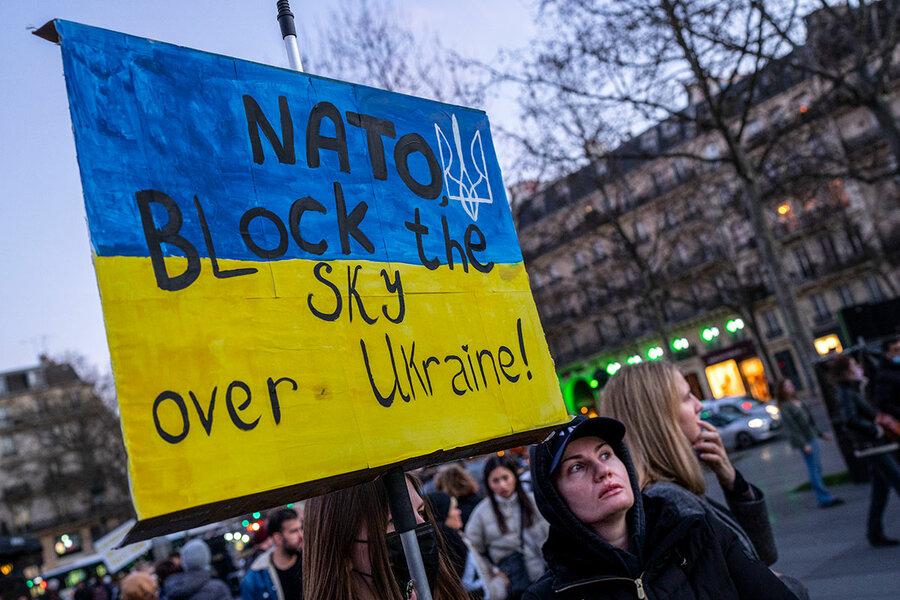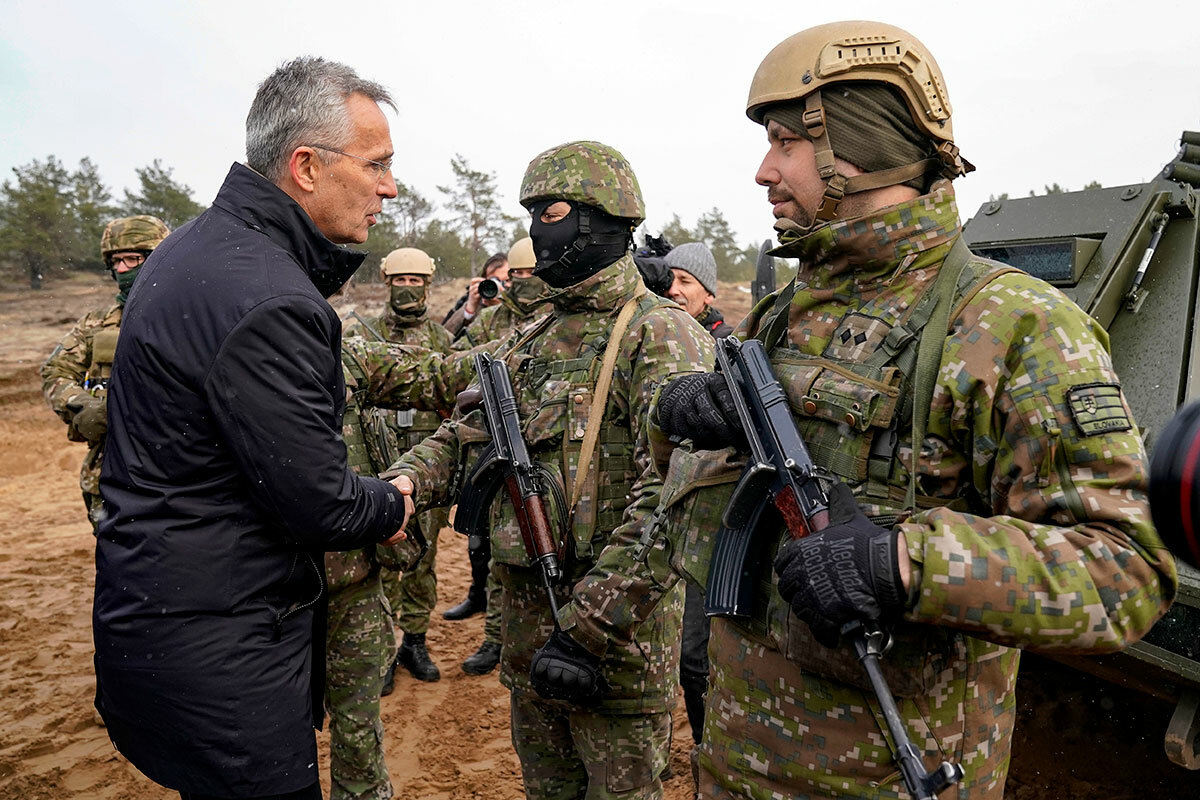Why a no-fly zone is a no-go for NATO
Loading...
| Brussels
When an open letter this week called for a no-fly zone for Ukraine, the former military officials writing it included retired Lt. Gen. Ben Hodges, who was commander of the United States Army in Europe from 2014 to 2017.
“I signed [it] partly because it’s so hard to watch video every day of civilians being targeted,” says Mr. Hodges.
Why We Wrote This
Horrors including the bombing of a maternity hospital have amplified calls for NATO to create a no-fly zone over Ukraine. But an idea that some see as a “moral imperative” is fraught with moral complexity.
A no-fly zone is supported by many Ukrainians as well as many onlookers to the conflict. Yet war is an arena where moral imperatives run headlong into moral complexity. Enforcing a no-fly zone could escalate the conflict and risk even greater human suffering. That’s a key reason that NATO leaders and outside experts on military conflict have opposed the idea, opting instead for other ways of aiding Ukraine.
NATO air engagement over Ukraine could also become a propaganda tool for Russian President Vladimir Putin to justify his invasion.
In the days since signing the letter, Mr. Hodges’ own views on a no-fly zone have evolved. “I’ve endorsed it,” he says, but today he believes the best option for countering Russia is “caution, calmness, and keeping the alliance together.”
As the excruciating videos streamed in from Ukraine this week – crying mothers cradling their babies after the Russian destruction of a maternity hospital among them – calls intensified for a no-fly zone over the country to protect civilians.
It’s a moral imperative, petitioners said.
“If you do not do this, you will have to share the responsibility for the lives and suffering of the civilian population of Ukraine who are being killed by rocket attacks from Russian planes,” Ukrainian Foreign Minister Dmytro Kuleba told the NATO alliance.
Why We Wrote This
Horrors including the bombing of a maternity hospital have amplified calls for NATO to create a no-fly zone over Ukraine. But an idea that some see as a “moral imperative” is fraught with moral complexity.
Yet war is an arena where moral imperatives run headlong into moral complexity. Enforcing a no-fly zone could escalate the conflict and risk even greater human suffering. That’s a key reason that NATO leaders and outside experts on military conflict have opposed the idea, opting instead for other ways of aiding Ukraine.
“In my judgment a no-fly zone would be the equivalent of luring NATO or the U.S. into a war with Russia,” says Richard Kohn, former chief historian for the United States Air Force and now professor emeritus at the University of North Carolina at Chapel Hill.
It would also help Russian President Vladimir Putin to justify what he’s doing, he adds. “He would be able to say, ‘Look, NATO is killing our boys.’ It would provide a propaganda victory and help Putin combat opposition in Russia. That’s not something you want to do.”
So, although calls for the use of Western air power to help Ukraine are rooted in dreadful anticipation and understandable outrage, U.S. and NATO military leaders have been batting them down with what some see as stony pragmatism.
“We are not part of this conflict,” NATO Secretary-General Jens Stoltenberg said last week after the alliance denied Ukraine’s no-fly zone request.
On this, there has been rare U.S. bipartisan agreement. Republican Sen. Marco Rubio of Florida called no-fly zones a “catchphrase” that could lead to “basically the beginning of World War III.” Democratic Sen. Chris Murphy of Connecticut said they are “a bad idea,” and tweeted that “shooting down Russian planes would require a declaration of war from Congress – which isn’t happening.”
That said, there are plenty of ways the alliance has been willing to help Ukraine, including by sending in machine guns, ammunition, rocket launchers, and, as one U.S. military official put it, “enough Javelins [missiles] to counter every Russian tank.”
The Ukrainians have used these weapons to great effect, defense officials note. But Russia, “to make up for their lack of ground movement and the lack of air superiority,” is stepping up its missile strikes and “dumb bombs,” a senior U.S. defense official said this week. Because of their lack of precision guidance, these arms are more likely to hit civilian targets.
This in turn raises the likelihood of yet more heart-rending footage of human misery in the weeks to come. Yet amid calls to “do something,” leaders will be sure to attend to another goal – avoiding scenarios that risk drawing nuclear weapons into the conflict.
Mr. Stoltenberg of NATO alluded to the dilemma. “We understand the desperation” in Ukraine, he said. But the aim is to avoid “something that could lead to a full-fledged war in Europe involving many more countries and much more suffering.”
“So hard to watch”
Retired Lt. Gen. Ben Hodges, commander of the U.S. Army in Europe from 2014 to 2017, was one of a number of signatories to a widely publicized letter this week calling for a limited no-fly zone for Ukraine. Its authors ran the spectrum from former senior Pentagon officials to a former supreme allied commander of NATO.
“I signed a letter endorsing the idea partly because it’s so hard to watch video every day of civilians being targeted,” says Mr. Hodges, in Frankfurt, Germany.
But in the days since, he has reflected on whether it’s actually the best way forward. “I’ve endorsed it, but as I keep thinking about it, I don’t think it’s going to be the solution.”
Today, he believes the best bet for countering Russia is “caution, calmness, and keeping the alliance together,” says Mr. Hodges, who is now Pershing Chair at the Washington-based Center for European Policy Analysis. “I’m not against a no-fly zone, but I am against doing it without the alliance agreeing to it.”
The alliance is against a no-fly zone in large part because it is not the simple endeavor that the phrase seems to suggest: Namely, it requires shooting down aircraft and destroying air defense systems based in Russia.
“When the FAA issues a ‘no-fly’ order, everybody stops flying,” says retired Col. Mark Cancian, senior adviser to the International Security Program at the Center for Strategic and International Studies in Washington. “In a military situation, adversaries will ignore it and so you have to enforce it.”
And that “would mean someone would have to then go and fight against Russian air forces,” Gen. Mark Milley, chairman of the Joint Chiefs of Staff, explained last week during a press briefing in Latvia.
This is why Mr. Putin can justifiably warn that those who take part in a no-fly zone would be “participating in the armed conflict.”
What no-fly zones can and can’t do
In the past the U.S. and NATO have imposed no-fly zones only when their air power is so overwhelming that it can be done without much – but still some – combat. This was largely the case in Iraq in 1992, when a no-fly zone was established to shield the Kurds from attack by Saddam Hussein, as well as in Bosnia-Herzegovina in 1993, to protect the new country from air attacks by Bosnian Serb forces. It was also true in Libya in 2011, when NATO established a no-fly zone amid fears that Libyan leader Muammar Qaddafi would commit war crimes.
In Ukraine, NATO would not only have to contend with Russian aircraft in its skies, but also with the Russian surface-to-air missiles that blanket nearly all of the country.
What’s more, the vast majority of the harm that Russia is inflicting is coming from artillery and missiles, not bombs dropped by aircraft.
Of the more than 710 missiles that Russia has launched against Ukraine, half are coming from inside Russia, according to the Pentagon. The rest are coming from Russian systems inside Ukraine, with a handful coming from Belarus and Russian ships in the Black Sea.
To help Ukraine defend against this onslaught, NATO and even formerly neutral nations like Sweden and Finland are rushing weapons into Ukraine, including machine guns, rockets, and even Stinger surface-to-air missiles, to help them defend against Russian aircraft and tanks.
Indeed, within a week of President Joe Biden’s approval, most of the $350 million in a new package of U.S. military aid had already landed in Ukraine, “which is an unbelievable level of speed,” a senior defense official noted in a press briefing Tuesday.
Time is of the essence as the Russian military works to encircle and isolate Ukraine’s major cities.
In the meantime, the great powers continue to test their deconfliction phone line, with about a dozen calls since the war began. “We want to keep making sure it’s working,” the senior defense official said this week. “We make the phone call, see if somebody’s picking up, then acknowledge each other’s presence and hang up.”
It’s an acknowledgment, too, that averting any misunderstandings that could ultimately lead to nuclear war is NATO’s overarching moral imperative – and the greatest challenge the alliance must weigh.









